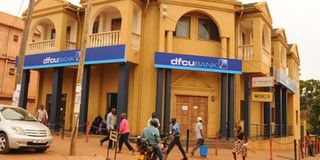dfcu Bank profit up by 25% as dividend reaches Shs25.2

dfcu Bank acquired some of the assets and liabilities of Crane Bank in January this year. FILE PHOTO
What you need to know:
- In February, Bank of Uganda (BoU) reduced the Central Bank Rate by 0.5 percentage points to 11.5 per cent, saying the move is meant to stimulate economic activities in the country which have persistently remained low.
- Latest data from the BoU’s State of the Economy Report released last December noted that “the domestic economic growth outlook remains subdued.”
Kampala. Dfcu Bank has reported a 25 per cent jump in after-tax profit in 2016 after a good return was made on investments in government securities.
In results published on Tuesday, the after-tax profit of dfcu was Shs46.2b in 2016 up from Shs37b at the end of 2015.
dfcu, which acquired some of the assets and liabilities of Crane Bank in January this year, attributed this rise in profitability to the strategic placement in government securities investments.
According to the financial statements, income from government securities grew by 66 per cent to Shs72.2b in 2016.
Government securities offered higher yields 2016 as banks slowed down in lending to the private sector.
dfcu’s investment in government securities rose for both those held till maturity and those that are traded.
This investment rose 20 per cent to Shs489b in 2016.
The bank’s focus was generating more income from government securities is a reflection of the slugging growth income from lending to the private sector.
This income only grew by 3 per cent to Shs143.5b despite an expansion of the loan book in the second half of 2016.
In a brief response to Daily Monitor, Mr Juma Kisaame, the managing director dfcu said this was because of the “cautious lending due to economic slowdown combined with the impact of Prime Interest lending rate reduction over the year.”
That caution is also seen in the dfcu non-performing loan book portfolio that declined from Shs71.2b in 2015 to Shs58.5b in 2016.
According to Kisaame, this was in part due to “a few significant upgrades from NPA to performing as a result of close monitoring.”
Banks exercised caution in 2016, after a surge in the general trend of delayed loan repayments.
The estimates are that by end of December 2016, the total NPLs in the industry were at an average of about Shs900b.
With the improved performance of the bank in 2016, the shareholders dfcu Limited will be earning Shs25.19 dividend per share, up from Shs21.73.
The dfcu results do not reflect the Crane Bank acquisition because it was made in January 2017 yet the results reflect the performance of the bank in 2016.
Shareholders will have to wait until August 2017 when the half year 2017 results will be released.
DTB writes off Shs34b loans
The other bank that released financial results is Diamond Trust Bank (DTB).
The major highlight from the bank’s results is a significant loan write-off of Shs34bn in 2016, compared to just Shs5.9b in 2015.
However, DTB management is only willing to comment on the issue once financial results for the entire banking sector are released.
Also, the bank saw its NPLs drop significantly to Shs28.3b in 2016, down from Shs69.2b in 2015. DTB was also cautious in 2016 by slowing down lending to the private sector but was also able to generate more income because of the higher interest rates.
As a result, DTB’s after-tax profit rose 9 per cent to Shs21.5b in 2016.
KCB Group realises Shs1 trillion pre-tax earnings
KCB Group rode on a strong loan and deposit growth as well as improved operating efficiencies to post a Shs1.01 trillion in Pre-Tax profit for the full year ending December 31, 2016.
Earnings before tax rose 10 per cent from Shs923.7 billion posted the same period last year, KCB Group chief executive officer and managing director Mr Joshua Oigara, said, attributing the headway to the bank’s continued and deliberate focus on growth, efficiency, and value creation for shareholders.
“Our strategic focus to consistently deliver on excellent customer experience, drive credit growth and secure new business opportunities has helped guarantee positive performance. We are committed to bolstering this model to build a sustainable business for the future,” said Mr Oigara.
KCB Group Chairman Ngeny Biwott, said: “We saw sustained business resilience in a relatively tough macro-economic environment across the East African region. Markets like South Sudan, Burundi and Uganda experienced business shocks, as was the case with Kenya where an interest capping regime redefined the operating environment.”
He added: “We have in place a responsive operating model which came into play through the difficult times in the year. We are optimistic of an improved macro-economic environment in 2017, even as Kenya and Rwanda go through elections later in the year.”
BoU move
In February, Bank of Uganda (BoU) reduced the Central Bank Rate by 0.5 percentage points to 11.5 per cent, saying the move is meant to stimulate economic activities in the country which have persistently remained low.
The Central Bank also reduced Uganda’s economic growth rate to 4.5 per cent for this financial year ending June 30, 2017.
Latest data from the BoU’s State of the Economy Report released last December noted that “the domestic economic growth outlook remains subdued.”




